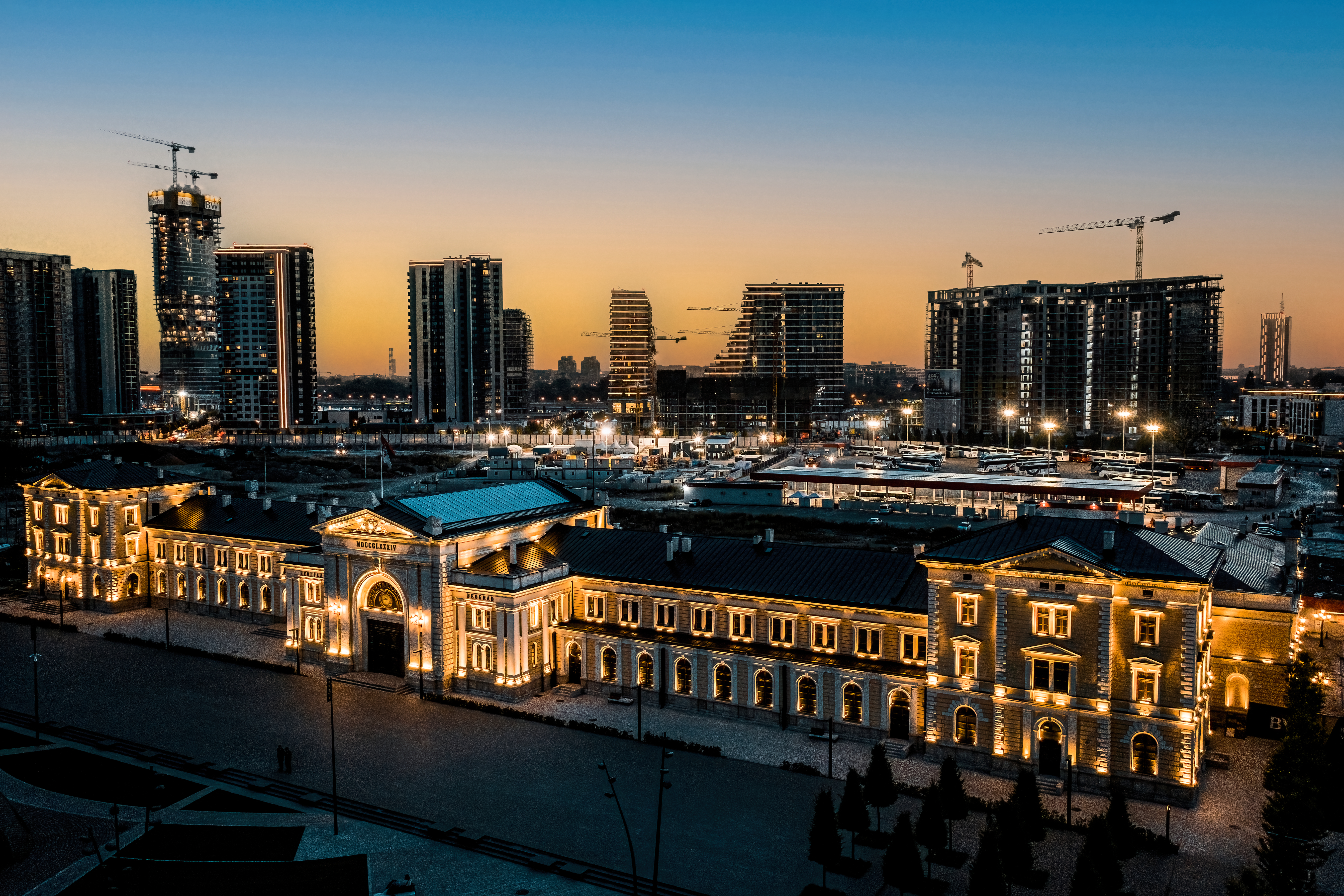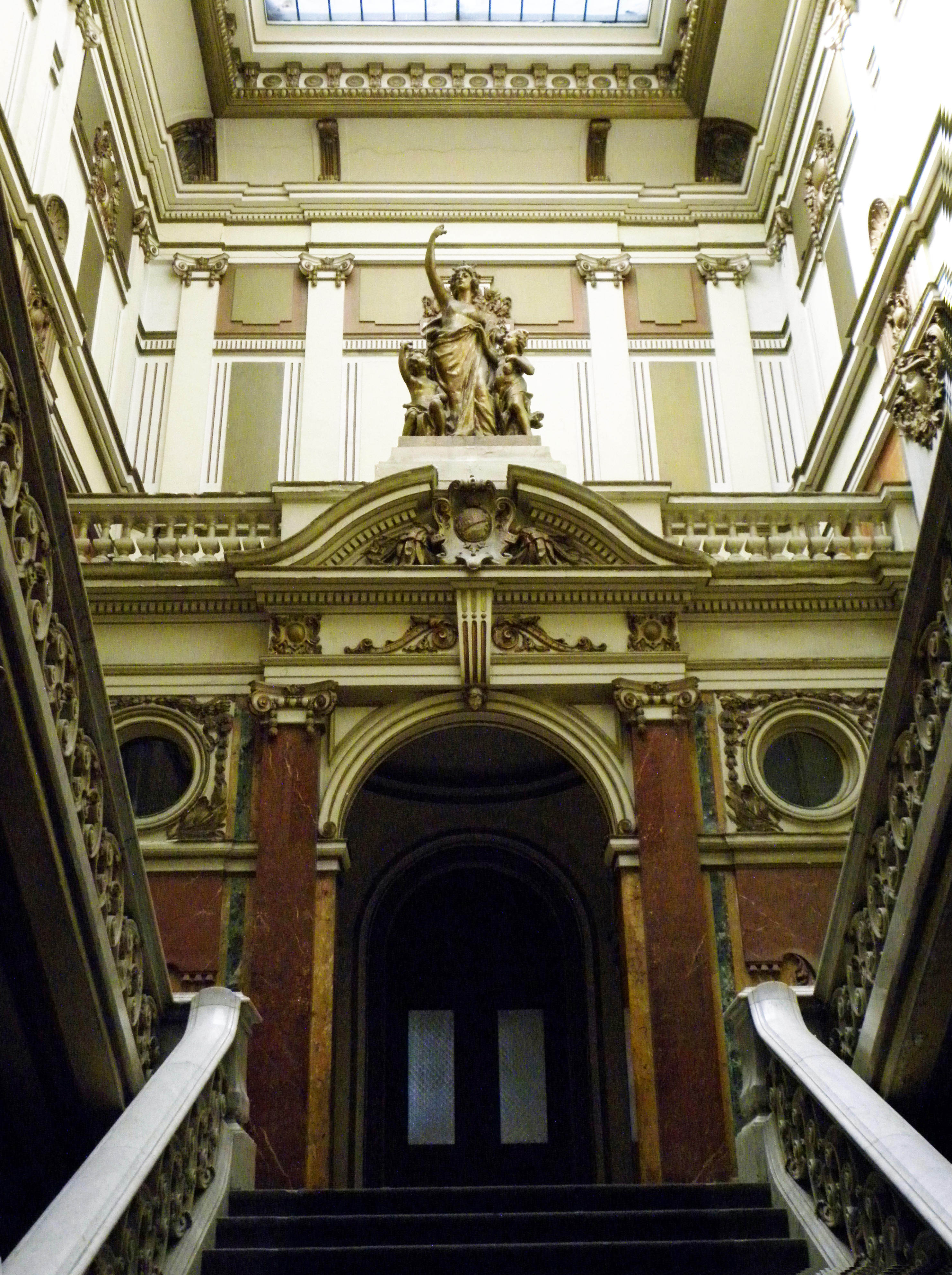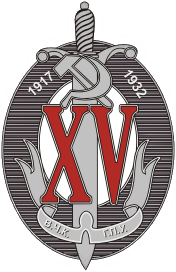|
Old Post Office (Belgrade)
The Old Post Office, is a former building in Belgrade, modern-day Serbia. Located next to Belgrade Main railway station, it was considered to be one of the most beautiful buildings and symbols of the city. Built in Serbo-Byzantine Revival style upon plans by Momir Korunović, Post Office was mostly destroyed by Allied bombing of Yugoslavia in World War II and later reconstructed in 1947 in a functionalist style. Location The building is located just south of the Belgrade Main railway station, in the southern corner of the Sava Square, at 2 Savska Street. It is situated in the neighborhood of Bara Venecija, or the extreme south extension of Savamala. Being at the beginning of the Savska Street, it is across the Saint Sava Hospital, while the Monument to Stefan Nemanja and pedestrian section of the Ssva Square are to the northeast. History Origin Built as the Post Office No. 2 in the 1920s, it was constructed by architect Momir Korunović, nicknamed Serbian Gaudi. Du ... [...More Info...] [...Related Items...] OR: [Wikipedia] [Google] [Baidu] |
Serbo-Byzantine Revival
The Modern Serbo-Byzantine architectural style, Neo-Byzantine architectural style or Serbian national architectural style is the style in Serbian architecture which lasted from the second half of the 19th century to the first half of the 20th century. This style originated in the tradition of medieval Serbian-Byzantine school and was part of international Neo-Byzantine style. History and characteristics The beginning of the modern Serbian-Byzantine style lies in the romantic spirit, which was prevalent in Europe in the first half of the 19th century, and in the Serbian lands appeared by the mid-century and was alive to its last decades. The beginning of this style can be seen as "resistance" to newcomers' influences of the "western-style" (Classicism, Neo-Baroque) in the Principality of Serbia. The style is characterized by forms and decorations from the Serbian-Byzantine architectural heritage. This architectural approach is not strictly tied to the church architecture; in ... [...More Info...] [...Related Items...] OR: [Wikipedia] [Google] [Baidu] |
Politika
''Politika'' ( sr-Cyrl, Политика; ''Politics'') is a Serbian daily newspaper, published in Belgrade. Founded in 1904 by Vladislav F. Ribnikar, it is the oldest daily newspaper still in circulation in the Balkans. Publishing and ownership ''Politika'' is published by Politika novine i magazini (PNM), a joint venture between Politika AD and ''East Media Group''. The current director of PNM is Mira Glišić Simić. PNM also publishes: *'' Sportski žurnal'' *'' Politikin zabavnik'' *''Svet kompjutera'' *''Ilustrovana politika'' *''Bazar'' Editorial history * Vladislav F. Ribnikar (1904–1915) *Miomir Milenović i Jovan Tanović (1915–1941) *Živorad Minović (1985–1991) *Aleksandar Prlja (1991–1994) *Boško Jakšić (1994) *Dragan Hadži Antić (1994–2000) *Vojin Partonić (2000–2001) *Milan Mišić (2001–2005) * Ljiljana Smajlović (2005–2008) *Radmilo Kljajić (2008) *Dragan Bujošević (2008–2013) * Ljiljana Smajlović (2013–2016) *Žarko Rakić ... [...More Info...] [...Related Items...] OR: [Wikipedia] [Google] [Baidu] |
Buildings And Structures In Belgrade
A building, or edifice, is an enclosed structure with a roof and walls standing more or less permanently in one place, such as a house or factory (although there's also portable buildings). Buildings come in a variety of sizes, shapes, and functions, and have been adapted throughout history for a wide number of factors, from building materials available, to weather conditions, land prices, ground conditions, specific uses, prestige, and aesthetic reasons. To better understand the term ''building'' compare the list of nonbuilding structures. Buildings serve several societal needs – primarily as shelter from weather, security, living space, privacy, to store belongings, and to comfortably live and work. A building as a shelter represents a physical division of the human habitat (a place of comfort and safety) and the ''outside'' (a place that at times may be harsh and harmful). Ever since the first cave paintings, buildings have also become objects or canvasses of much artisti ... [...More Info...] [...Related Items...] OR: [Wikipedia] [Google] [Baidu] |
Belgrade Waterfront
Belgrade Waterfront, known in Serbian as Belgrade on Water ( sr, / ), is an urban renewal development project headed by the Government of Serbia aimed at improving Belgrade's cityscape and economy by revitalizing the Sava amphitheater, a neglected stretch of land on the right bank of the Sava river, between the Belgrade Fair and Branko's bridge. It was started in 2014 with the reconstruction of the Belgrade Cooperative building, which was finished in June of the same year. It is the second largest mixed use complex under construction in Europe, just after Minsk Mir, worth 3.5 billion dollars. Belgrade Waterfront complex will include 7,000 residential units for 14,000 residents, luxury hotels including W Hotel and St. Regis, 2000 offices, the largest shopping mall in southeast Europe, and public buildings within a total construction area of 1.8 million sq. The project was initiated in 2014 between the Government of Serbia and Eagle Hills, a leading Abu Dhabi-based private inv ... [...More Info...] [...Related Items...] OR: [Wikipedia] [Google] [Baidu] |
BIGZ Building
The BIGZ building ( sr, Зграда БИГЗ-а, Zgrada BIGZ-a) is a building located in Belgrade, the capital of Serbia. Designed by Dragiša Brašovan, it is one of the most representative architectural landmarks of Serbian modern architecture. A monumental building, with its position, volume and aesthetics, it dominates the entrance in the southern section of Belgrade. It has been protected since 1992. In recent times it represents a significant cultural, artistic and social spot. Location The BIGZ building is located at 17 ''Bulevar vojvode Mišića'', in the Mostar section of the Senjak neighborhood, west of the Mostar looped interchange on the Highway Belgrade–Niš. Just east of the building is the Radisson Collection Hotel, Old Mill Belgrade, declared a cultural monument in 1987. Across the ''Bulevar vojvode Mišića'', the facilities of the Belgrade Fair are located. With its height and monumentality, it dominates the skyline and presents a reference point not ... [...More Info...] [...Related Items...] OR: [Wikipedia] [Google] [Baidu] |
National Museum Of Serbia
The National Museum of Serbia ( sr, / ) is the largest and oldest museum in Belgrade, Serbia. It is located in the central zone of Belgrade on a square plot between the Republic Square, formerly Theatre Square, and three streets: Čika Ljubina, Vasina and Laze Pačua. Its main facade is on the Republic Square and the official address ia 1a Republic Square. The museum was established on 10 May 1844. It moved into the present building in 1950, with the grand opening of the venue on 23 May 1952. Since its founding, the museum's collection has grown to over 400,000 objects, including many foreign masterpieces. The National Museum of Serbia building was declared a Monument of Culture of Great Importance in 1979. History Before the erection of the building of the National Museum on this place was a famous tavern called "Dardanelles", meeting point of the cultural and artistic elite of the time. Demolition of the old tavern signified the beginning of the transformation of The ... [...More Info...] [...Related Items...] OR: [Wikipedia] [Google] [Baidu] |
Belgrade Cooperative
Belgrade Cooperative ( sr, Београдска задруга) was a cooperative bank founded in 1882 to promote savings and support small enterprises, craftspeople and the poor of Belgrade. Member-shareholders have been paying membership in amount of one Serbian Dinar per week. That is the way for cooperative to become a public savings bank. Luka Ćelović was the first president of cooperative, also a first Serbian insurance group. Origin and construction The construction of Belgrade Cooperative coincided with the change of political regime in Serbia. After the assassination of the king Aleksandar Obrenović, the Karadjordjevic dynasty came to power, which led to a change in the system of governance. Autocratic regime was replaced by liberal bourgeois regime of Petar the I, the civil liberties were increased and the economic situation was improved. "Belgrade cooperative for mutual help and savings" was founded in 1882 at the initiative of a group of Belgrade merchants ... [...More Info...] [...Related Items...] OR: [Wikipedia] [Google] [Baidu] |
Pošta Srbije
Pošta Srbije ( sr-Cyrl, Пошта Србије, lit=Post of Serbia) is the national postal service of Serbia, with the headquarters in Belgrade. Public postal service was first introduced in Serbia in 1840. The first stamp was printed in 1866. In 1874 it founded the Universal Postal Union together with 21 other countries. History * 1840 – First public postal service introduced in Serbia * 1866 – The first Postal Law was passed and the first postal stamp was issued. * 1874 – Serbia among 21 founding members of Universal Postal Union in Bern, Switzerland. * 1945 – Serbian Post becomes state-owned enterprise. * 1989 – Serbian post restructured as Public Enterprise of PTT Saobraćaja "Srbija". * 1997 – PTT Saobraćaja "Srbija" transformed into holding company (Telekom Srbija founded). * 2001 – Serbia re-entered the Universal Postal Union * 2003 – Rail transport of postal items discontinued. * 2005 – New Postal Services Law enacted. * 2010 – Law on Postal Servic ... [...More Info...] [...Related Items...] OR: [Wikipedia] [Google] [Baidu] |
NKVD
The People's Commissariat for Internal Affairs (russian: Наро́дный комиссариа́т вну́тренних дел, Naródnyy komissariát vnútrennikh del, ), abbreviated NKVD ( ), was the interior ministry of the Soviet Union. Established in 1917 as NKVD of the Russian Soviet Federative Socialist Republic, the agency was originally tasked with conducting regular police work and overseeing the country's prisons and labor camps. It was disbanded in 1930, with its functions being dispersed among other agencies, only to be reinstated as an all-union commissariat in 1934. The functions of the OGPU (the secret police organization) were transferred to the NKVD around the year 1930, giving it a monopoly over law enforcement activities that lasted until the end of World War II. During this period, the NKVD included both ordinary public order activities, and secret police activities. The NKVD is known for its role in political repression and for carrying out the Great ... [...More Info...] [...Related Items...] OR: [Wikipedia] [Google] [Baidu] |
OGPU
The Joint State Political Directorate (OGPU; russian: Объединённое государственное политическое управление) was the intelligence and state security service and secret police of the Soviet Union from 1923 to 1934. The OGPU was formed from the State Political Directorate of the Russian Soviet Federative Socialist Republic one year after the founding of the Soviet Union and responsible to the Council of People's Commissars. The agency operated inside and outside the Soviet Union, persecuting political criminals and opponents of the Bolsheviks such as White émigrés, Soviet dissidents, and anti-communists. The OGPU was based in the Lubyanka Building in Moscow and headed by Felix Dzerzhinsky until his death in 1926 and then Vyacheslav Menzhinsky until it was reincorporated as the Main Directorate of State Security (GUGB) of the NKVD in 1934. History Founding Following the formation of the Soviet Union in December 1922, t ... [...More Info...] [...Related Items...] OR: [Wikipedia] [Google] [Baidu] |
Socialist Realism
Socialist realism is a style of idealized realistic art that was developed in the Soviet Union and was the official style in that country between 1932 and 1988, as well as in other socialist countries after World War II. Socialist realism is characterized by the depiction of communist values, such as the emancipation of the proletariat. Despite its name, the figures in the style are very often highly idealized, especially in sculpture, where it often leans heavily on the conventions of classical sculpture. Although related, it should not be confused with social realism, a type of art that realistically depicts subjects of social concern, or other forms of "realism" in the visual arts. Socialist realism was made with an extremely literal and obvious meaning, usually showing an idealized USSR. Socialist realism was usually devoid of complex artistic meaning or interpretation. Socialist realism was the predominant form of approved art in the Soviet Union from its development in ... [...More Info...] [...Related Items...] OR: [Wikipedia] [Google] [Baidu] |
World War II
World War II or the Second World War, often abbreviated as WWII or WW2, was a world war that lasted from 1939 to 1945. It involved the World War II by country, vast majority of the world's countries—including all of the great powers—forming two opposing military alliances: the Allies of World War II, Allies and the Axis powers. World War II was a total war that directly involved more than 100 million Military personnel, personnel from more than 30 countries. The major participants in the war threw their entire economic, industrial, and scientific capabilities behind the war effort, blurring the distinction between civilian and military resources. Air warfare of World War II, Aircraft played a major role in the conflict, enabling the strategic bombing of population centres and deploying the Atomic bombings of Hiroshima and Nagasaki, only two nuclear weapons ever used in war. World War II was by far the List of wars by death toll, deadliest conflict in hu ... [...More Info...] [...Related Items...] OR: [Wikipedia] [Google] [Baidu] |




.jpg)




